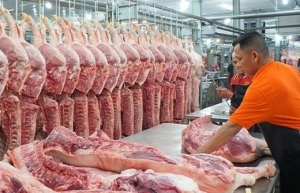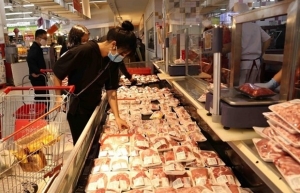Confusing aspects of pork prices must be dealt with
 |
| Vu Vinh Phu - Former chairman Hanoi Supermarket Association |
The price of live hogs has dropped to less than the breeding cost, leading to a sharp decrease in meat prices at wet markets. However, the prices in supermarkets are still 40-60 per cent higher than in such markets. This contrasts with the retail price of goods abroad, where supermarkets mostly offer lower prices than other markets because they can utilise the strength of capital, branding, and a large global distribution chain.
Big distributors and supermarkets in Vietnam are not being fair to consumers. To delay price reductions and apply discounts in a short time, big retailers are delivering very costly pork to customers. While people’s purchasing power has yet to recover after the pandemic, the government, ministries, businesses, and consumers are doing their utmost to overcome difficulties, but there are many head-scratching aspects to pork prices that need to be dealt with.
On the other hand, data shows that while the total circulation of retail goods and social consumption services in 2022 were estimated to have grown by over 10 per cent, the retail scale for the year reached only 80 per cent of pre-pandemic levels. The reason for the current slowdown in purchasing power is caused by the economic recession, with people cutting their spending not only in Vietnam but all over the world. This had a negative impact on the consumption of pork, in addition to the tendency of it being replaced by chicken and seafood in domestic diets.
Besides the unreasonable prices at large retailers, pork prices include intermediate costs, import costs in large retailers, and other costs during goods circulation. So, we need solutions to increase sales and stimulate social purchasing power until the end of the year.
There are various options that should be considered. Firstly, the production process needs to increase quantity and quality to meet high standards to enter all available retail shops and distribution channels.
Secondly, a national distribution system with short supply chains directly connecting production and retail needs to be built to remove all intermediary stages and unnecessary costs, developing retailers that do good business, welcoming suppliers, cooperatives, farmers, and their agricultural products to distribution channels.
Thirdly, close links between production, import, and retailers must be created ensuring benefits between the different stages in the production and distribution chain, while resolving any obstacles.
Fourthly, the market must be managed to combat speculation and unfair pricing practices, especially as pork accounts for 60-70 per cent of the meals of every Vietnamese family. Smuggling, commercial fraud, and tax evasion have to be tackled head on. We should pull down the selling price to protect the rights of consumers, while also helping producers and farmers.
Finally, it is key that we promote the role of fair and objective retail associations such as the Vietnam Competition Authority and the Vietnam Consumer Protection Association, while protecting them and other associations against inappropriate practices in the organisation of supply, sales, and consumption, which have been prevalent for many years.
 | Government orders immediate measures to stabilise pork prices In light of the rising price of pork and feed ingredients in recent times, Deputy Prime Minister Le Minh Khai has asked relevant authorised agencies to take immediate measures to ensure supply and demand and stabilise prices. |
 | Market attempts to stabilise pork prices A rise in pork has benefited some husbandry companies in Vietnam, with the government ordering stabilising measures to help rein in inflation at around 4 per cent this year. |
What the stars mean:
★ Poor ★ ★ Promising ★★★ Good ★★★★ Very good ★★★★★ Exceptional
Related Contents
Latest News
More News
- First members of Danang International Finance Centre revealed (December 22, 2025 | 17:39)
- Human-centred governance seen as key to AI development (December 19, 2025 | 18:19)
- Top 10 notable events of Vietnam’s industry and trade sector in 2025 (December 19, 2025 | 14:00)
- Tungsten surges to 12-year high as world enters a new 'black gold' race (December 18, 2025 | 17:27)
- Vietnam’s coffee exports set new record despite price pressures (December 18, 2025 | 17:13)
- Garment and textile sector seeks new growth after volatile year (December 18, 2025 | 17:01)
- VinSpeed and Siemens strengthen cooperation for high-speed rail development (December 18, 2025 | 16:53)
- High-tech adoption for TH true MILK (December 18, 2025 | 13:39)
- Takeda supports health resilience amid climate change challenges (December 18, 2025 | 12:39)
- Mondelez Kinh Do - a chapter of purpose-led leadership in Vietnam (December 18, 2025 | 09:44)

 Tag:
Tag:






















 Mobile Version
Mobile Version